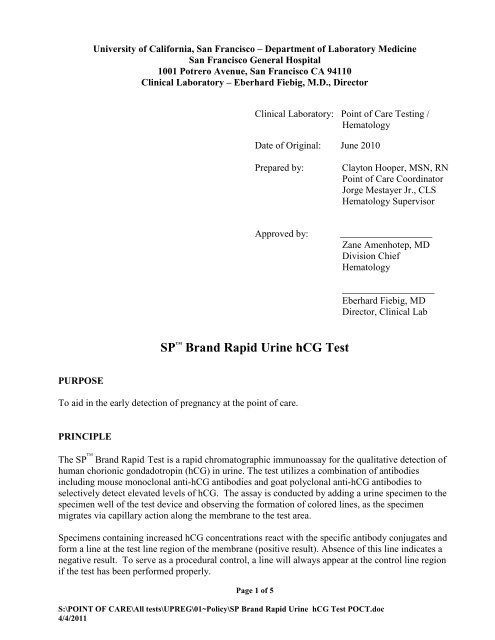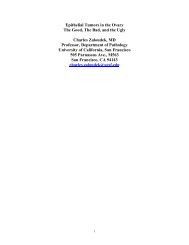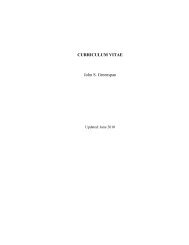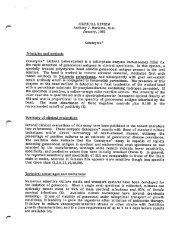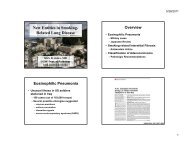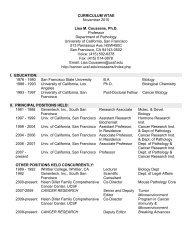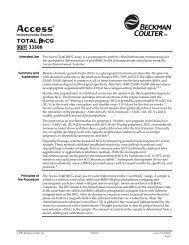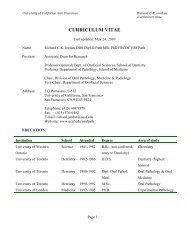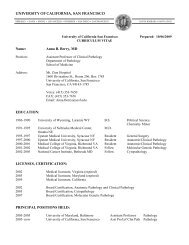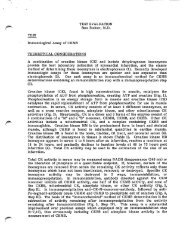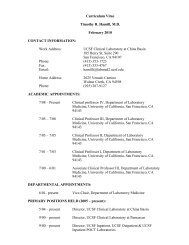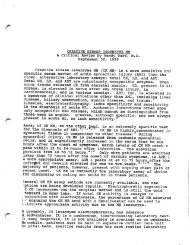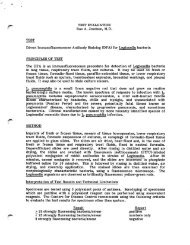Urine Pregnancy Test - Departments of Pathology and Laboratory ...
Urine Pregnancy Test - Departments of Pathology and Laboratory ...
Urine Pregnancy Test - Departments of Pathology and Laboratory ...
Create successful ePaper yourself
Turn your PDF publications into a flip-book with our unique Google optimized e-Paper software.
PURPOSE<br />
University <strong>of</strong> California, San Francisco – Department <strong>of</strong> <strong>Laboratory</strong> Medicine<br />
San Francisco General Hospital<br />
1001 Potrero Avenue, San Francisco CA 94110<br />
Clinical <strong>Laboratory</strong> – Eberhard Fiebig, M.D., Director<br />
SP TM<br />
Page 1 <strong>of</strong> 5<br />
Clinical <strong>Laboratory</strong>: Point <strong>of</strong> Care <strong>Test</strong>ing /<br />
Hematology<br />
Date <strong>of</strong> Original: June 2010<br />
Prepared by: Clayton Hooper, MSN, RN<br />
Point <strong>of</strong> Care Coordinator<br />
Jorge Mestayer Jr., CLS<br />
Hematology Supervisor<br />
Approved by: ___________________<br />
Zane Amenhotep, MD<br />
Division Chief<br />
Hematology<br />
Br<strong>and</strong> Rapid <strong>Urine</strong> hCG <strong>Test</strong><br />
To aid in the early detection <strong>of</strong> pregnancy at the point <strong>of</strong> care.<br />
PRINCIPLE<br />
S:\POINT OF CARE\All tests\UPREG\01~Policy\SP Br<strong>and</strong> Rapid <strong>Urine</strong> hCG <strong>Test</strong> POCT.doc<br />
4/4/2011<br />
___________________<br />
Eberhard Fiebig, MD<br />
Director, Clinical Lab<br />
The SP TM<br />
Br<strong>and</strong> Rapid <strong>Test</strong> is a rapid chromatographic immunoassay for the qualitative detection <strong>of</strong><br />
human chorionic gondadotropin (hCG) in urine. The test utilizes a combination <strong>of</strong> antibodies<br />
including mouse monoclonal anti-hCG antibodies <strong>and</strong> goat polyclonal anti-hCG antibodies to<br />
selectively detect elevated levels <strong>of</strong> hCG. The assay is conducted by adding a urine specimen to the<br />
specimen well <strong>of</strong> the test device <strong>and</strong> observing the formation <strong>of</strong> colored lines, as the specimen<br />
migrates via capillary action along the membrane to the test area.<br />
Specimens containing increased hCG concentrations react with the specific antibody conjugates <strong>and</strong><br />
form a line at the test line region <strong>of</strong> the membrane (positive result). Absence <strong>of</strong> this line indicates a<br />
negative result. To serve as a procedural control, a line will always appear at the control line region<br />
if the test has been performed properly.
UPREG Point <strong>of</strong> Care <strong>Test</strong>ing/Hematology<br />
June 2010<br />
TESTING PERSONNEL<br />
SPECIMEN<br />
Qualified Licensed Registered Nurses (RNs) <strong>and</strong> approved Health Care Providers<br />
A. First morning urine specimen is preferred – this sample contains the highest<br />
concentration <strong>of</strong> hCG hormone.<br />
B. The urine collection container should be clean <strong>and</strong> dry, <strong>and</strong> must not contain any<br />
preservatives.<br />
NOTE: <strong>Test</strong> should not be performed on urine specimens exhibiting visible<br />
precipitates.<br />
C. Stability: up to 48 hours refrigerated at 2-8 o C.<br />
EQUIPMENT<br />
REAGENTS<br />
A. Disposable specimen droppers (included in test pouch)<br />
B. Package insert<br />
C. Specimen collection container<br />
D. Timer<br />
Br<strong>and</strong> Rapid <strong>Test</strong> cassettes contain anti-hCG gold conjugate <strong>and</strong> anti-hCG coated on the<br />
membrane.<br />
SP TM<br />
Storage <strong>and</strong> Stability:<br />
Store as packaged in the sealed pouch at 2-30º C. The test cassette is stable through the<br />
expiration date printed on the sealed pouch. The test cassette must remain in the sealed<br />
pouch until use. DO NOT FREEZE. Do not use beyond the expiration date.<br />
QUALITY CONTROL<br />
Internal Quality Controls:<br />
Internal quality controls are included in the test. A line appearing in the control region (C) is<br />
the positive internal quality control. It confirms sufficient specimen volume <strong>and</strong> correct<br />
procedural technique. A clear background is an internal negative background control. If the<br />
test is working properly, the background in the result area should be white <strong>and</strong> not interfere.<br />
Page 2 <strong>of</strong> 5<br />
S:\POINT OF CARE\All tests\UPREG\01~Policy\SP Br<strong>and</strong> Rapid <strong>Urine</strong> hCG <strong>Test</strong> POCT.doc<br />
4/4/2011
UPREG Point <strong>of</strong> Care <strong>Test</strong>ing/Hematology<br />
June 2010<br />
External Quality Control <strong>Test</strong>ing:<br />
Controls are run on all new lot numbers or shipments <strong>of</strong> test cassettes <strong>and</strong> as needed by the<br />
Clinical <strong>Laboratory</strong> prior to distribution.<br />
PROCEDURE:<br />
Allow the test cassette <strong>and</strong> urine to equilibrate to room temperature prior to testing.<br />
A. Using two patient identifiers, verify the patient’s identity, <strong>and</strong> explain the procedure<br />
to patient <strong>and</strong>/or family.<br />
B. Observe universal precautions; wear gloves <strong>and</strong> other personal protective equipment<br />
as appropriate.<br />
C. Label a urine cup with the patient’s name <strong>and</strong> Medical Record Number <strong>and</strong> h<strong>and</strong> it<br />
to the patient for urine collection.<br />
NOTE: Pre-collected urine specimens (i.e., from home) must meet acceptable<br />
Specimen Criteria (see SPECIMEN heading prior page) <strong>and</strong> be labeled with two<br />
patient identifiers.<br />
D. The test device should be at room temperature before it is removed from its protective<br />
pouch. This avoids condensation <strong>of</strong> moisture on the test membrane.<br />
E. Remove the test cassette from the sealed pouch <strong>and</strong> use it as soon as possible.<br />
F. Label the test cassette with the patient’s name <strong>and</strong> Medical Record Number.<br />
G. Place the test cassette on a clean <strong>and</strong> level surface. Hold the dropper vertically <strong>and</strong><br />
transfer 3 full drops <strong>of</strong> urine (approx. 100µl) to the specimen well <strong>of</strong> the test<br />
cassette, <strong>and</strong> then start the timer. Avoid trapping air bubbles in the specimen well.<br />
H. Wait for the line to appear. The result should be read at 3 minutes. It is important<br />
that the background is clear before the result is read.<br />
NOTE: A low hCG concentration might result in a weak line appearing in the test<br />
region (T) after <strong>and</strong> extended period <strong>of</strong> time; therefore, do not interpret the result<br />
after 5 minutes.<br />
I. Record date, patient’s Medical Record Number, test result, <strong>and</strong> QC result on log<br />
maintained in the nursing unit where test is performed. Chart test result on patient’s<br />
medical record.<br />
I. Discard the test cassette in a proper biohazard container after testing.<br />
Page 3 <strong>of</strong> 5<br />
S:\POINT OF CARE\All tests\UPREG\01~Policy\SP Br<strong>and</strong> Rapid <strong>Urine</strong> hCG <strong>Test</strong> POCT.doc<br />
4/4/2011
UPREG Point <strong>of</strong> Care <strong>Test</strong>ing/Hematology<br />
June 2010<br />
INTERPRETATION OF TEST RESULTS:<br />
POSITIVE: Two distinct lines appear. One line should be in the control region (C) <strong>and</strong><br />
another line should be in the test region (T).<br />
NOTE: The intensity <strong>of</strong> the line in the test region (T) will vary depending on the<br />
concentration <strong>of</strong> hCG present in the specimen. However, neither the quantitative<br />
value nor the rate <strong>of</strong> increase in hCG can be determined by this qualitative test.<br />
NEGATIVE: One line appears in the control region (C). No apparent line appears in the<br />
test region (T).<br />
INVALID: Control line fails to appear. Insufficient specimen volume or incorrect<br />
procedural techniques are the most likely reasons for control line failure. Review the<br />
procedure <strong>and</strong> repeat the test with a new test device. If the problem persists, discontinue<br />
using the test kit immediately <strong>and</strong> contact the Point <strong>of</strong> Care Service at 415.206.8588.<br />
REPORTING RESULTS:<br />
Negative results are expected in healthy non-pregnant women. Healthy pregnant women<br />
have hCG present in their urine <strong>and</strong> serum specimens. The amount <strong>of</strong> hCG will vary greatly<br />
with gestational age <strong>and</strong> between individuals.<br />
The SP TM<br />
Br<strong>and</strong> Rapid <strong>Test</strong> has a sensitivity <strong>of</strong> 20 mIU/mL, <strong>and</strong> is capable <strong>of</strong> detecting<br />
pregnancy as early as 1 day after the first missed menses.<br />
PROCEDURE NOTES:<br />
Sensitivity <strong>and</strong> Specificity: The SP TM<br />
Br<strong>and</strong> Rapid <strong>Test</strong> detects hCG at a concentration <strong>of</strong> 20<br />
mIU/mL or greater. The test has been st<strong>and</strong>ardized to the W.H.O. Fourth International<br />
St<strong>and</strong>ard.<br />
LIMITATIONS:<br />
This test cassette is for pr<strong>of</strong>essional in vitro diagnostic use only. Do not use after the<br />
expiration date. The test cassette should remain in the sealed pouch until use.<br />
A. Very dilute urine specimens, as indicated by a low specific gravity, may not contain<br />
representative levels <strong>of</strong> hCG <strong>and</strong> give a negative result. If pregnancy is still<br />
suspected, a first morning urine specimen should be collected 48 hours later <strong>and</strong><br />
tested.<br />
B. False negative results may occur when the levels <strong>of</strong> hCG are below the sensitivity<br />
level <strong>of</strong> the test. When pregnancy is still suspected, a first morning urine specimen<br />
Page 4 <strong>of</strong> 5<br />
S:\POINT OF CARE\All tests\UPREG\01~Policy\SP Br<strong>and</strong> Rapid <strong>Urine</strong> hCG <strong>Test</strong> POCT.doc<br />
4/4/2011
UPREG Point <strong>of</strong> Care <strong>Test</strong>ing/Hematology<br />
June 2010<br />
should be collected 48 hours later <strong>and</strong> tested.<br />
C. Very low levels <strong>of</strong> hCG (less than 50 mIU/mL) are present in urine specimen shortly<br />
after implantation. However, because a significant number <strong>of</strong> first trimester<br />
pregnancies terminate for natural reasons, a test result that is weakly positive may be<br />
confirmed by retesting with a first morning urine specimen collected 48 hours later.<br />
D. A number <strong>of</strong> conditions other than pregnancy, including trophoblastic disease <strong>and</strong><br />
certain non-trophoblastic neoplasms including some breast cancer tumors <strong>and</strong> lung<br />
cancer tumors may cause elevated levels <strong>of</strong> hCG. Therefore, the presence <strong>of</strong> hCG in<br />
urine specimen should not be used to diagnose pregnancy unless these conditions<br />
have been ruled out.<br />
E. Gross hematuria may prevent an accurate reading <strong>of</strong> the test result by masking a<br />
positive line.<br />
F. The test provides a presumptive diagnosis for pregnancy. A confirmed pregnancy<br />
diagnosis should only be made by a physician after all clinical <strong>and</strong> laboratory findings<br />
have been evaluated.<br />
CONFIRMATORY TESTING<br />
If the clinical impression does not agree with the SP TM<br />
Br<strong>and</strong> Rapid <strong>Test</strong> result, <strong>and</strong> repeat testing on<br />
a fresh first morning urine sample collected 48 hours after the initial sample is not an appropriate<br />
option, a blood sample may be submitted to the Clinical <strong>Laboratory</strong> for quantitative serum hCG<br />
hormone measurement.<br />
REFERENCES:<br />
DISTRIBUTION:<br />
A. SP TM<br />
Br<strong>and</strong> Rapid <strong>Test</strong> package insert, Revised 10-07<br />
A. Point <strong>of</strong> Care Master Procedure Book (2M14).<br />
B. Approved Point <strong>of</strong> Care <strong>Test</strong>ing Locations.<br />
SIGNED: Zane Amenhotep, MD, Division Chief Hematology; Eberhard Fiebig, MD, Director<br />
Page 5 <strong>of</strong> 5<br />
S:\POINT OF CARE\All tests\UPREG\01~Policy\SP Br<strong>and</strong> Rapid <strong>Urine</strong> hCG <strong>Test</strong> POCT.doc<br />
4/4/2011


